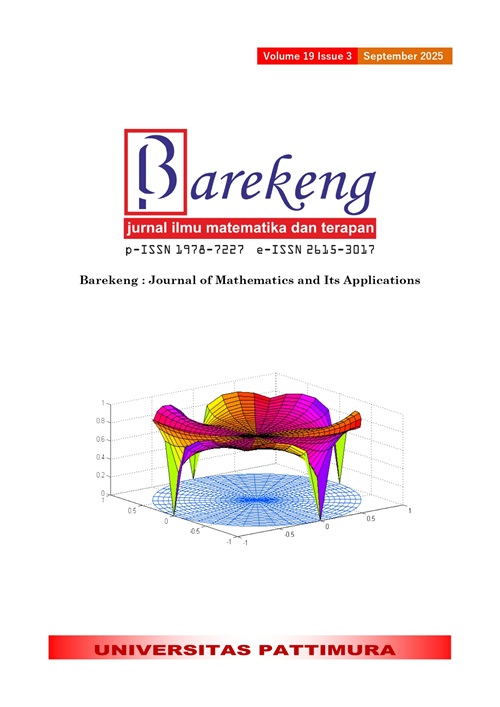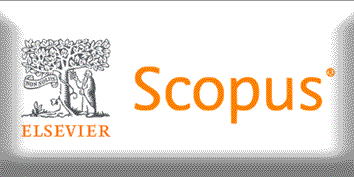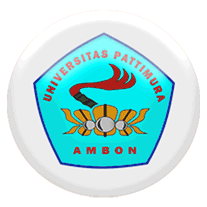FUZZY GEOGRAPHICALLY WEIGHTED CLUSTERING WITH OPTIMIZATION ALGORITHMS FOR SOCIAL VULNERABILITY ANALYSIS IN JAVA ISLAND
Abstract
The Social Vulnerability Index (SoVI) measurement assesses social vulnerability. However, the measurement of SoVI can only describe the general conditions without being able to show which factors dominate. Therefore, a clustering approach has been proposed to characterise the dominant social vulnerability factors. Fuzzy Geographically Weighted Clustering (FGWC) is a method that works for this purpose. FGWC is an extension of the Fuzzy C-Means algorithm, which involves geographical influences in calculating membership values. However, the FGWC method is sensitive because the initial initialisation to determine the centroid is randomised, and it will affect the cluster quality. This research uses a metaheuristic approach to overcome the weakness of FGWC by using Particle Swarm Optimisation (PSO) and Artificial Bee Colony (ABC). This study aims to cluster districts/cities in Java Island using the PSO-FGWC and ABC-FGWC methods based on social vulnerability variables and determine the dominant factors of social vulnerability in each region. Optimum cluster selection uses the index of the largest Partition Coefficient (PC) and the smallest Classification Entropy (CE). Clustering social vulnerability in Java Island resulted in the best clustering using the ABC-FGWC method with 5 optimum clusters based on the PC and CE index values of 0.343 and 1.298, respectively. This research found that social vulnerability exists in each region of Java Island. Cluster 1, consisting of 19 districts/cities, is characterized by vulnerabilities in demography and education. Cluster 2, consisting of 33 districts/cities, is characterized by demographic and health vulnerabilities. Cluster 3, which consists of 24 districts/cities, is dominated by education and economic vulnerability factors. Cluster 4, consisting of 14 districts/cities, has the highest social vulnerability characteristics on the unemployment rate and the proportion of house rent. The last one, cluster 5, consists of 29 districts/cities and has a vulnerability problem in the population growth variable.
Downloads
References
P. P. BNPB, BUKU DATA BENCANA INDONESIA TAHUN 2023, vol. 3. Jakarta: Pusdatinkom BNPB, 2024.
S. J. Hejazi, A. Sharifi, and M. Arvin, “ASSESSMENT OF SOCIAL VULNERABILITY IN AREAS EXPOSED TO MULTIPLE HAZARDS: A CASE STUDY OF THE KHUZESTAN PROVINCE, IRAN,” International Journal of Disaster Risk Reduction, vol. 7, no. 8, pp. 103–127, Aug. 2022, doi: https://doi.org/10.1016/j.ijdrr.2022.103127.
R. Maulidin, I. Indra, and Y. Abubakar, “KAJIAN TINGKAT KERENTANAN SOSIAL TERHADAP MASYARAKAT TERDAMPAK BENCANA DI KECAMATAN TRIENGGADENG PASCA GEMPA BUMI PIDIE JAYA 2016,” Jurnal IPA & Pembelajaran IPA, vol. 6, no. 4, pp. 341–355, Dec. 2022, doi: https://doi.org/10.24815/jipi.v6i4.28353.
Y. N. Maharani, A. R. B. Nugroho, D. F. Adiba, and I. Sulitiyowati, “PENGARUH KERENTANAN SOSIAL TERHADAP KETANGGUHAN MASYARAKAT DALAM MENGHADAPI BENCANA ERUPSI GUNUNG MERAPI DI KABUPATEN SLEMAN.,” Jurnal Dialog Penanggulangan Bencana, vol. 11, no. 1, pp. 1–12, 2020.
F. Fatemi, A. Ardalan, B. Aguirre, N. Mansouri, and I. Mohammadfam, “SOCIAL VULNERABILITY INDICATORS IN DISASTERS: FINDINGS FROM A SYSTEMATIC REVIEW,” International Journal of Disaster Risk Reduction, vol. 22, pp. 219–227, Jun. 2017, doi: https://doi.org/10.1016/j.ijdrr.2016.09.006.
M. Munirwansyah, R. P. Munirwan, M. Sungkar, and Z. Melinda, “THE EFFECT OF SOIL-STRUCTURE INTERACTION ON MULTI-STOREY BUILDING RESONANCE AND DYNAMIC SHEAR MODULUS FOR PIDIE JAYA ACEH EARTHQUAKE,” IOP Conf Ser Mater Sci Eng, vol. 523, no. 1, p. 12038, May 2019, doi: https://doi.org/10.1088/1757-899X/523/1/012038.
UNISDR, “IMPLEMENTATION OF THE HYOGO FRAMEWORK FOR ACTION: SUMMARY OF REPORTS 2007-2013,” Geneva, Switzerland, 2014.
A. Fadlurohman, N. A. N. Roosyidah, and N. A. Annisa, “SOCIAL VULNERABILITY ANALYSIS IN CENTRAL JAVA WITH K-MEDOIDS ALGORITHM,” Parameter: Journal of Statistics, vol. 4, no. 2, 2024.doi: https://doi.org/10.22487/27765660.2024.v4.i2.17131
E. Puspitotanti and M. Karmilah, “KAJIAN KERENTANAN SOSIAL TERHADAP BENCANA BANJIR,” Jurnal Kajian Ruang, vol. 1, no. 2, pp. 177–197, Jan. 2022, doi: https://doi.org/10.30659/jkr.v1i2.20023.
S. L. Cutter, “VULNERABILITY TO ENVIRONMENTAL HAZARDS,” Prog Hum Geogr, vol. 20, no. 4, pp. 529–539, Dec. 1996, doi: https://doi.org/10.1177/030913259602000407.
s. L. Cutter, b. J. Boruff, and w. L. Shirley, “social vulnerability to environmental hazards *,” soc sci q, vol. 84, no. 2, pp. 242–261, jun. 2003, doi: https://doi.org/10.1111/1540-6237.8402002.
J. Birkmann, N. J. Setiadi, and N. Gebert, “SOCIO-ECONOMIC VULNERABILITY AT THE LOCAL LEVEL IN CONTEXT OF TSUNAMY EARLY WAR EVACUATION PLANNING IN THE CITY OF PADANG, WEST SUMATERA,” in Proceedings of the International Conference on Tsunami Warning (ICTW), Bali, 2008.
T. H. Siagian, P. Purhadi, S. Suhartono, and H. Ritonga, “SOCIAL VULNERABILITY TO NATURAL HAZARDS IN INDONESIA: DRIVING FACTORS AND POLICY IMPLICATIONS,” Natural Hazards, vol. 70, no. 2, pp. 1603–1617, Jan. 2014, doi: https://doi.org/10.1007/s11069-013-0888-3.
B. I. Nasution, R. Kurniawan, T. H. Siagian, and A. Fudholi, “REVISITING SOCIAL VULNERABILITY ANALYSIS IN INDONESIA: AN OPTIMIZED SPATIAL FUZZY CLUSTERING APPROACH,” International Journal of Disaster Risk Reduction, vol. 51, pp. 1–11, Dec. 2020, doi: https://doi.org/10.1016/j.ijdrr.2020.101801.
G. A. Mason and R. D. Jacobson, “FUZZY GEOGRAPHICALLY WEIGHTED CLUSTERING,” in Proceedings of the 9th International Conference on Geocomputation, 2007.
A. W. Wijayanto, S. Mariyah, and A. Purwarianti, “ENHANCING CLUSTERING QUALITY OF FUZZY GEOGRAPHICALLY WEIGHTED CLUSTERING USING ANT COLONY OPTIMIZATION,” in 2017 International Conference on Data and Software Engineering (ICoDSE), IEEE, Nov. 2017, pp. 1–6. doi: https://doi.org/10.1109/ICODSE.2017.8285858.
L. H. Son, P. L. Lanzi, B. C. Cuong, and H. A. Hung, “DATA MINING IN GIS: A NOVEL CONTEXT-BASED FUZZY GEOGRAPHICALLY WEIGHTED CLUSTERINGALGORITHM,” Int J Mach Learn Comput, vol. 2, no. 3, pp. 235–238, 2012, doi: https://doi.org/10.7763/IJMLC.2012.V2.121.
L. H. Son, B. C. Cuong, P. L. Lanzi, and N. T. Thong, “A NOVEL INTUITIONISTIC FUZZY CLUSTERING METHOD FOR GEO-DEMOGRAPHIC ANALYSIS,” Expert Syst Appl, vol. 39, no. 10, pp. 9848–9859, Aug. 2012, doi: https://doi.org/10.1016/j.eswa.2012.02.167.
D. S. Sara, “FUZZY GEOGRAPHICALLY WEIGHTED CLUSTERING UNTUK PENGELOMPOKAN INDIKATOR KESEJAHTERAAN RAKYAT DI PROVINSI JAWA TENGAH,” Skripsi, Universitas Muhammadiyah Semarang, Semarang, 2018.
B. S. Hadi, “PENDEKATAN MODIFIED PARTICLE SWARM OPTIMIZATION DAN ARTIFICIAL BEE COLONY PADA FUZZY GEOGRAPHICALLY WEIGHTED CLUSTERING,” Disertasi, Institut Teknologi Sepuluh Nopember, Surabaya, 2017.
N. Nurmala and A. Purwarianti, “IMPROVEMENT OF FUZZY GEOGRAPHICALLY WEIGHTED CLUSTERING-ANT COLONY OPTIMIZATION PERFORMANCE USING CONTEXT-BASED CLUSTERING AND CUDA PARALLEL PROGRAMMING,” Journal of ICT Research and Applications, vol. 11, no. 1, pp. 21–37, Apr. 2017, doi: https://doi.org/10.5614/itbj.ict.res.appl.2017.11.1.2.
Z. Feng and R. Flowerdew, “FUZZY GEODEMOGRAPHICS,” in Innovations in GIS 5, Abingdon, UK: Taylor & Francis, 1998, pp. 119–127. doi: https://doi.org/10.4324/9780203478776_chapter_ELEVEN.
C. Blum and A. Roli, “METAHEURISTICS IN COMBINATORIAL OPTIMIZATION,” ACM Comput Surv, vol. 35, no. 3, pp. 268–308, Sep. 2003, doi: https://doi.org/10.1145/937503.937505.
A. M. Rizki and A. L. Nurlaili, “ALGORITME PARTICLE SWARM OPTIMIZATION (PSO) UNTUK OPTIMASI PERENCANAAN PRODUKSI AGREGAT MULTI-SITE PADA INDUSTRI TEKSTIL RUMAHAN,” Journal of Computer, Electronic, and Telecommunication, vol. 1, no. 2, Jan. 2021, doi: https://doi.org/10.52435/complete.v1i2.73.
D. Choudhury and T. Acharjee, “A NOVEL PARTICLE SWARM OPTIMIZATION-BASED INTELLIGENCE LINK PREDICTION ALGORITHM IN REAL WORLD NETWORKS,” Bulletin of Electrical Engineering and Informatics, vol. 13, no. 3, pp. 1980–1990, Jun. 2024, doi: https://doi.org/10.11591/eei.v13i3.6761.
D. T. Santosh et al., “DEVELOPMENT OF IOT BASED INTELLIGENT IRRIGATION SYSTEM USING PARTICLE SWARM OPTIMIZATION AND XGBOOST TECHNIQUES,” Bulletin of Electrical Engineering and Informatics, vol. 13, no. 3, pp. 1927–1934, Jun. 2024, doi: https://doi.org/10.11591/eei.v13i3.6332.
S. Yahdin et al., “COMBINATION OF KNN AND PARTICLE SWARM OPTIMIZATION (PSO) ON AIR QUALITY PREDICTION,” BAREKENG: Jurnal Ilmu Matematika dan Terapan, vol. 16, no. 1, pp. 007–014, Mar. 2022, doi: https://doi.org/10.30598/barekengvol16iss1pp007-014.
B. Akay and D. Karaboga, “A MODIFIED ARTIFICIAL BEE COLONY ALGORITHM FOR REAL-PARAMETER OPTIMIZATION,” Inf Sci (N Y), vol. 19, no. 2, pp. 120–142, Jun. 2012, doi: https://doi.org/10.1016/j.ins.2010.07.015.
Y. Witanto, “OPTIMISASI ALGORITMA K-MEANS MENGGUNAKAN ARTIFICIAL BEE COLONY PADA CONTENT-BASED IMAGE RETRIEVAL,” Jurnal Repositor, vol. 3, no. 1, pp. 97–110, Dec. 2020, doi: https://doi.org/10.22219/repositor.v3i1.1180.
A. W. Wijayanto and A. Purwarianti, “IMPROVEMENT DESIGN OF FUZZY GEO-DEMOGRAPHIC CLUSTERING USING ARTIFICIAL BEE COLONY OPTIMIZATION,” in 2014 International Conference on Cyber and IT Service Management (CITSM), IEEE, Nov. 2014, pp. 69–74. doi: https://doi.org/10.1109/CITSM.2014.7042178.
Y. S. Paradilla, M. N. Hayati, and S. Sifriyani, “IMPLEMENTATION OF THE FUZZY GUSTAFSON-KESSEL METHOD ON GROUPING DISTRICTS/CITIES IN KALIMANTAN ISLAND BASED ON POVERTY ISSUES FACTORS,” BAREKENG: Jurnal Ilmu Matematika dan Terapan, vol. 17, no. 1, pp. 0125–0134, Apr. 2023, doi: https://doi.org/10.30598/barekengvol17iss1pp0125-0134.
T. Wakui, E. M. Agree, T. Saito, and I. Kai, “DISASTER PREPAREDNESS AMONG OLDER JAPANESE ADULTS WITH LONG-TERM CARE NEEDS AND THEIR FAMILY CAREGIVERS,” Disaster Med Public Health Prep, vol. 11, no. 1, pp. 31–38, Feb. 2017, doi: https://doi.org/10.1017/dmp.2016.53.
S. Rufat, “SPECTROSCOPY OF URBAN VULNERABILITY,” Annals of the Association of American Geographers, vol. 103, no. 3, pp. 505–525, May 2013, doi: https://doi.org/10.1080/00045608.2012.702485.
T. D. Putri, Sunarsih, and F. Muhammad, “ANALYSIS OF COMMUNITY SOCIAL VULNERABILITY AND CLIMATE CHANGE ADAPTATION IN GEMBLAKAN ATAS VILLAGE, YOGYAKARTA CITY,” in Proceeding Biology Education Conference, 2019, pp. 256–264.
K. W. Nelson, “CHOICES AND OPPORTUNITIES: LOW‐INCOME RENTAL HOUSING IN INDONESIA*,” Review of Urban & Regional Development Studies, vol. 1, no. 2, pp. 49–63, Jul. 1989, doi: https://doi.org/10.1111/j.1467-940X.1989.tb00012.x.
G. N. Mankiw, MACROECONOMICS SEVENTH EDITION, 7th ed. NewYork: Worth Publishers, 2010.
Copyright (c) 2025 Alwan Fadlurohman, Tiani Wahyu Utami, Setiawan Amrullah, Nila Ayu Nur Roosyidah, Oktaviana Rahma Dhani

This work is licensed under a Creative Commons Attribution-ShareAlike 4.0 International License.
Authors who publish with this Journal agree to the following terms:
- Author retain copyright and grant the journal right of first publication with the work simultaneously licensed under a creative commons attribution license that allow others to share the work within an acknowledgement of the work’s authorship and initial publication of this journal.
- Authors are able to enter into separate, additional contractual arrangement for the non-exclusive distribution of the journal’s published version of the work (e.g. acknowledgement of its initial publication in this journal).
- Authors are permitted and encouraged to post their work online (e.g. in institutional repositories or on their websites) prior to and during the submission process, as it can lead to productive exchanges, as well as earlier and greater citation of published works.






1.gif)



